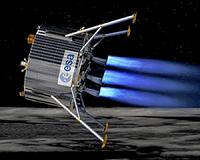 |
Providence RI (SPX) Sep 20, 2010 Take a cursory look at the moon, and it can resemble a pockmarked golf ball. The dimples and divots on its surface are testament that our satellite has withstood a barrage of impacts from comets, asteroids and other space matter throughout much of its history. Because the geological record of that pummeling remains largely intact, scientists have leaned on the moon to reconstruct the chaotic early days of the inner solar system. Now a team led by Brown University planetary geologists has produced the first uniform, comprehensive catalog of large craters on the moon that could shed light on the full-scale, planetary bombardment that characterized the inner solar system more than 4 billion years ago. In a paper appearing on the cover of Science, the team used data from the Lunar Orbiter Laser Altimeter, one of a suite of instruments aboard NASA's Lunar Reconnaissance Orbiter, to identify and map 5,185 craters that are 20 kilometers in diameter or larger. From the crater count and analysis, the team, which includes scientists from the Massachusetts Institute of Technology and the NASA Goddard Space Flight Center, determined the moon's oldest regions are the southern near side and the north-central far side. The group also confirmed that the South Pole-Aitken Basin is the oldest basin, meaning that any samples from there could be invaluable to further understanding the moon and other bodies of the inner solar system. In all, the findings "are telling us something about the infancy of the solar system," said James W. Head III, a planetary geologist at Brown and the paper's lead author. "It is clear we can find out and learn so much more from future missions, robotic or otherwise. There is so much to do." A major finding deals with the stream of projectiles pinballing throughout the inner solar system in its earliest days. For years, the prevailing wisdom was that the moon was buffeted by a volley of space matter that held a steady ratio between larger and smaller objects, which planetary scientists refer to as "size-frequency distribution." The bombardment activity has never been questioned. But in 2005, the size-frequency distribution was challenged. In a paper in Science, a group led by University of Arizona geologist Robert Strom hypothesized that the ratio of larger and smaller objects striking the moon had differed during its first billion years of existence. The Brown-led team's crater analysis lends added credence to that hypothesis. The researchers studied impact craters formed early in the moon's history (when major basins were created by large projectiles striking the surface) and compared them with those they knew were formed later (when objects struck lava flows that had covered these basins). They found that the oldest surfaces (located in the lunar highlands) bore crater markings indicating a greater ratio of larger projectiles. The group looked in particular at Orientale Basin, formed by a massive impactor about 3.8 billion years ago, and determined that this is approximately when the era of larger projectiles versus smaller projectiles ended. The finding opens a set of intriguing questions for what was going on in the inner solar system leading up to roughly the time that Orientale Basin was formed, said Caleb Fassett, a postdoctoral researcher at Brown and a contributing author on the paper. "We know the asteroid belt has been spinning off projectiles at a relatively constant rate for three and a half billion years," he said. "But now we go back earlier in the solar system's history, and suddenly things are completely different. That implies there's a different forcing to the asteroid belt. What has caused that different forcing is still not known." The scientists think the change may have been caused by the gravitational pull on the asteroid belt exerted by larger planets such as Jupiter and Saturn as they settled into their orbits, a temporary abundance of comets, an unexplained change in the size of matter emanating from the asteroid belt, or something else. The Lunar Orbiter Laser Altimeter - LOLA - measures the moon's surface topography at a vertical precision of 10 centimeters using laser pulses bounced off the lunar surface just 25 meters apart. "The topography of the moon has been measured before, but this takes it to another level with the accuracy of data points and spatial resolution," said Maria Zuber, a planetary geologist at MIT who earned her doctorate at Brown in 1986 and is a contributing author to the paper.
Share This Article With Planet Earth
Related Links Brown University Mars News and Information at MarsDaily.com Lunar Dreams and more
 Next Step For ESA's First Moon Lander
Next Step For ESA's First Moon LanderParis, France (ESA) Sep 17, 2010 Mission description: land autonomously with pinpoint precision near the Moon's south pole, a region full of dangerous boulders and high ridges. The aim of ESA's proposed precursor is to probe the moonscape's unknowns and test new technology to prepare for future human landings. The first mission to visit the south polar region of the Moon took a significant step forward when a further stud ... read more |
|
| The content herein, unless otherwise known to be public domain, are Copyright 1995-2010 - SpaceDaily. AFP and UPI Wire Stories are copyright Agence France-Presse and United Press International. ESA Portal Reports are copyright European Space Agency. All NASA sourced material is public domain. Additional copyrights may apply in whole or part to other bona fide parties. Advertising does not imply endorsement,agreement or approval of any opinions, statements or information provided by SpaceDaily on any Web page published or hosted by SpaceDaily. Privacy Statement |